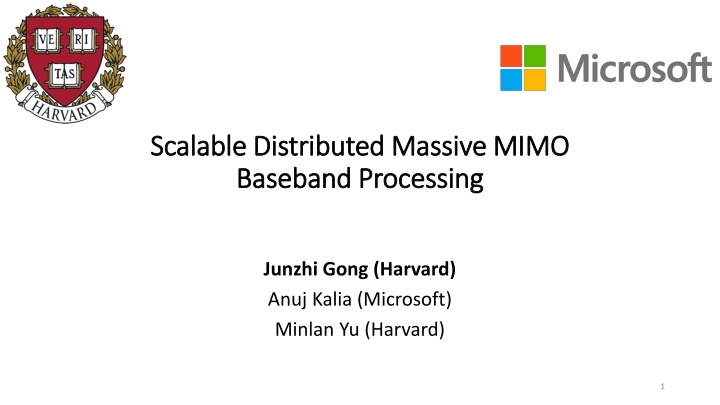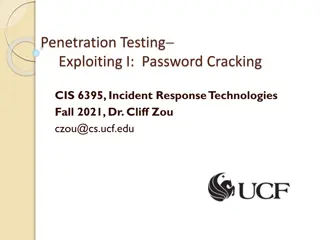
Unlocking the Potential of Massive MIMO Technology for 5G Networks
Discover the cutting-edge research on Scalable Distributed Massive MIMO, the significance of massive MIMO in achieving higher data rates in 5G networks, challenges in computation and wired communication, and solutions for scalability and efficiency in massive MIMO systems.
Uploaded on | 0 Views
Download Presentation

Please find below an Image/Link to download the presentation.
The content on the website is provided AS IS for your information and personal use only. It may not be sold, licensed, or shared on other websites without obtaining consent from the author. If you encounter any issues during the download, it is possible that the publisher has removed the file from their server.
You are allowed to download the files provided on this website for personal or commercial use, subject to the condition that they are used lawfully. All files are the property of their respective owners.
The content on the website is provided AS IS for your information and personal use only. It may not be sold, licensed, or shared on other websites without obtaining consent from the author.
E N D
Presentation Transcript
Scalable Distributed Massive MIMO Scalable Distributed Massive MIMO Baseband Processing Baseband Processing Junzhi Gong (Harvard) Anuj Kalia (Microsoft) Minlan Yu (Harvard) 1
Increasing traffic rate in 5G Increasing traffic rate in 5G Increased demand on mobile traffic rate 2 Image credit to Ericsson
Key to higher data rate in 5G: massive MIMO Key to higher data rate in 5G: massive MIMO M antennas Massive MIMO: with many antennas, many users can send/recv data at the same time, at the same frequency Radio unit (RU) Beamforming: focuses radio signals directly at the users, to eliminate interference Beamforming K users M K massive MIMO 3
Computation and wired communication challenges of massive MIMO Computation and wired communication challenges of massive MIMO Fronthaul traffic Baseband unit (BBU) M K massive MIMO Fronthaul packets (wireless signals) User bits 4
Computation and wired communication challenges of massive MIMO Computation and wired communication challenges of massive MIMO Fronthaul traffic RAN virtualization movement Commodity server M K massive MIMO 5
Computation and wired communication challenges of massive MIMO Computation and wired communication challenges of massive MIMO Agora [CoNEXT 20]: Needs 28 cores (a full server) for 64x16 MIMO Can t scale to larger MIMO configurations (e.g., 128x32) Single server is not enough Large amount of computation with more antennas/users Fronthaul traffic Commodity server M K massive MIMO High fronthaul bandwidth with more antennas 6
Inter/intra Inter/intra- -server communication limits scalability in prior massive MIMO systems server communication limits scalability in prior massive MIMO systems BigStation [SIGCOMM 10] State-of-the-art distributed solution Agora [CoNEXT 20] State-of-the-art single-server solution High inter-server communication High intra-server communication 2 1 Server 1 Server 2 Core 2 Core 1 Core 4 Core 3 Server 3 Server 4 Core N+1 Core N 7
Hydra: minimize inter and intra Hydra: minimize inter and intra- -server communication for scalability server communication for scalability Reduce inter-server communication overhead Exploit RU features to deliver fronthaul data directly to servers instead of shuffling the data among servers in prior designs Delay shuffling until later in the pipeline when the data size is reduced Reduce intra-server communication overhead Subcarrier-to-core affinity to minimize inter-core data movement Eliminate centralized task scheduling 8
Background: massive MIMO processing pipeline Background: massive MIMO processing pipeline Antenna-parallel User-parallel Subcarrier-parallel From RU To core network Equalization FFT Demodulation FEC decoding To RU From core network IFFT Precoding Modulation FEC encoding 9 9
Data dependency between stages introduces communication overhead Data dependency between stages introduces communication overhead Example: 120x30 MIMO, 1200 subcarriers Antenna-parallel User-parallel Subcarrier-parallel 40 packets 1 Server 1 Antennas 1-40 Antenna set 1 Subcarrier set 1 User set 1 From RU 40 packets Server 2 2 Antenna set 2 Subcarrier set 2 User set 2 Antennas 41-80 Server 3 40 packets 3 Antennas 81-120 Antenna set 3 Subcarrier set 3 User set 3 10 10
Data dependency between stages introduces communication overhead Data dependency between stages introduces communication overhead Example: 120x30 MIMO, 1200 subcarriers Antenna-parallel User-parallel Subcarrier-parallel 1 Server 1 Antenna set 1 Subcarrier set 1 User set 1 From RU Server 2 2 Antenna set 2 Subcarrier set 2 User set 2 Server 3 3 Antenna set 3 Subcarrier set 3 User set 3 11 11
Data dependency between stages introduces communication overhead Data dependency between stages introduces communication overhead Example: 120x30 MIMO, 1200 subcarriers Antenna-parallel User-parallel Subcarrier-parallel SC 1 SC 1200 1 ~5 KB Server 1 SC 1-400 Antenna set 1 Subcarrier set 1 User set 1 From RU SC 1 SC 1200 Server 2 2 SC 401-800 ~5 KB Antenna set 2 Subcarrier set 2 User set 2 SC 1 SC 1200 Server 3 3 ~5 KB SC 801-1200 Antenna set 3 Subcarrier set 3 User set 3 12 12
Data dependency between stages introduces communication overhead Data dependency between stages introduces communication overhead Example: 120x30 MIMO, 1200 subcarriers Antenna-parallel SC 1 User-parallel Subcarrier-parallel SC 1200 ~5 KB Server 1 Antenna set 1 Subcarrier set 1 User set 1 From RU SC 1 SC 1200 Server 2 ~5 KB Antenna set 2 Subcarrier set 2 User set 2 SC 1 SC 1200 Server 3 ~5 KB Antenna set 3 Subcarrier set 3 User set 3 13 13
Data dependency between stages introduces communication overhead Data dependency between stages introduces communication overhead Example: 120x30 MIMO, 1200 subcarriers Antenna-parallel SC 1 User-parallel Subcarrier-parallel SC 1200 ~5 KB Server 1 Antenna set 1 Subcarrier set 1 User set 1 From RU SC 1 SC 1200 Server 2 ~5 KB Antenna set 2 Subcarrier set 2 User set 2 SC 1 SC 1200 Server 3 ~5 KB Antenna set 3 Subcarrier set 3 User set 3 Scalability bottleneck: High rate (> 120 Gbps) of inter-server shuffling 14 14
Idea Idea #1: Exploit modern RU features to avoid data shuffling #1: Exploit modern RU features to avoid data shuffling Server 1 SC 1 SC 1200 ~5 KB Antenna set 1,2,3 Antenna set 1 Subcarrier set 1 User set 1 Server 2 Antenna set 2 Subcarrier set 2 User set 2 RU Server 3 Modern RU (O-RAN 7.2x) features Support FFT Antenna set 3 Subcarrier set 3 User set 3 15 15
Idea Idea #1: Exploit modern RU features to avoid data shuffling #1: Exploit modern RU features to avoid data shuffling Server 1 SC 1 SC 1200 Still high overhead from duplication ~5 KB Antenna set 1,2,3 Subcarrier set 1 User set 1 Server 2 Subcarrier set 2 User set 2 RU Server 3 Modern RU (O-RAN 7.2x) features Support FFT Subcarrier set 3 User set 3 16 16
Idea Idea #1: Exploit modern RU features to avoid data shuffling #1: Exploit modern RU features to avoid data shuffling Server 1 SC 1 SC 1200 ~5 KB Antenna set 1,2,3 Subcarrier set 1 User set 1 Server 2 Subcarrier set 2 User set 2 RU Server 3 Modern RU (O-RAN 7.2x) features Support FFT Configurable fronthaul packet segmentation Originally designed for MTU tuning Subcarrier set 3 User set 3 17
Idea Idea #1: Exploit modern RU features to avoid data shuffling #1: Exploit modern RU features to avoid data shuffling Server 1 SC 1 SC 1200 3 1 2 ~5 KB Antenna set 1,2,3 Subcarrier set 1 User set 1 Server 2 Subcarrier set 2 User set 2 RU Server 3 Modern RU (O-RAN 7.2x) features Support FFT Configurable fronthaul packet segmentation Originally designed for MTU tuning Subcarrier set 3 User set 3 18 18
Idea Idea #1: Exploit modern RU features to avoid data shuffling #1: Exploit modern RU features to avoid data shuffling Server 1 SC 1 SC 1200 ~5 KB Antenna set 1,2,3 Subcarrier set 1 User set 1 1 Server 2 Subcarrier set 2 User set 2 2 RU Server 3 Modern RU (O-RAN 7.2x) features Support FFT Configurable fronthaul packet segmentation Originally designed for MTU tuning Subcarrier set 3 User set 3 3 Hydra eliminates fronthaul shuffling by leveraging modern RU features 19 19
Observation: the pipeline progressively reduces the data size Observation: the pipeline progressively reduces the data size Shuffling here is more scalable! 4 x Per-antenna FP samples 25% 32 Gbps 128 Gbps 24 Gbps Per-user bits 8-byte FP signal 30 users 120 antennas 6-byte user bits Equalization FFT Demodulation FEC decoding Transform from antenna domain to user domain Converts wireless signals to user bits 20
Intuitive parallelization can increase inter Intuitive parallelization can increase inter- -server communication server communication Antenna set 1,2,3 Subcarrier- parallel User- parallel Subcarrier- parallel User- parallel RU Subcarrier- parallel User- parallel Matrix inversion for SC 800 Maximizing parallelism makes sense when CPUs are weak (e.g., BigStation) Limits scalability due to high inter-server communication with large numbers of antennas and users 21
Idea #2: Idea #2: Affinitize Affinitize subcarriers to a dedicated server subcarriers to a dedicated server Antenna set 1,2,3 User- parallel Subcarrier- parallel User- parallel Subcarrier- parallel User- parallel Subcarrier- parallel RU Matrix inversion for SC 800 Shuffling only after the subcarrier-parallel stage: low overhead due to data size reduction 22
Evaluation setup Evaluation setup Hardware configurations Four commodity servers Each server has two 16-core CPUs, with AVX2 support 100 GbE NIC Experiments were done with RU emulator Three servers for Hydra One server for RU emulator 23
Hydra is more scalable than Hydra is more scalable than existing systems existing systems 90 3 servers 72 CPU cores required 71 53 60 2 servers 44 32 28 30 19 1 server 0 64 16 128 16 128 32 150 32 MIMO settings Agora BigStation Hydra Hydra supports more challenging MIMO settings Experiment on more servers 27 servers in CloudLab (18 for Hydra, 9 for RU emulator) Hydra supports 256 32 MIMO (Uplink) with 18 servers 24
Conclusion: Hydras massive MIMO processing is scalable Conclusion: Hydra s massive MIMO processing is scalable We show that inter- and intra-server communication is a key scalability limiter in prior massive MIMO designs Hydra s scalability comes from Using features of modern RUs in novel ways Efficient computation partitioning Hydra supports 150 32 MIMO for the first time in software Hydra s scalability makes rapid development and deployment of 5G networks possible Thank you! 25

















